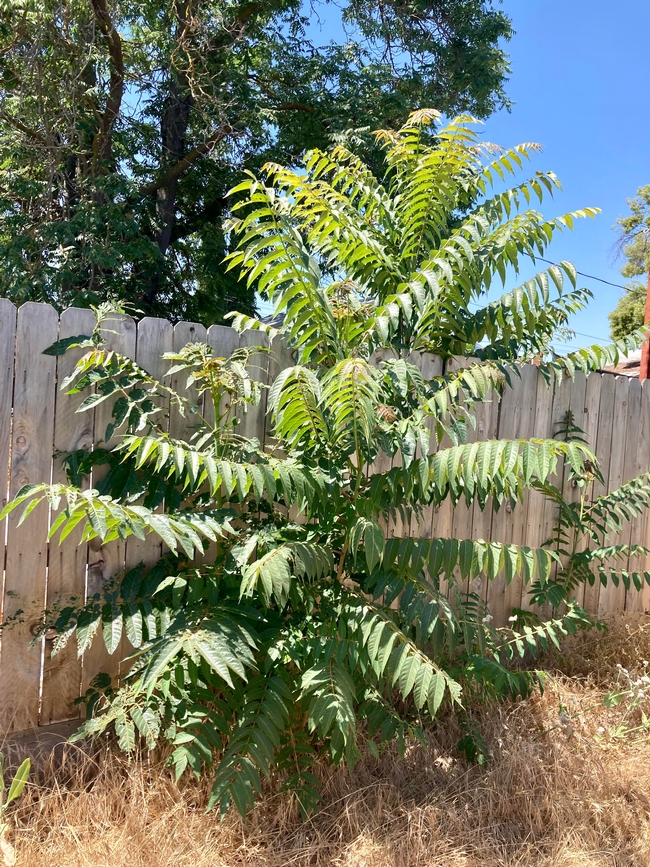
Tree-of-heaven is an invasive species from China that is found in many areas of Fresno County. The trees are easy to identify by their rapid growth, bark resembling cantaloupe rind, compound leaves and distinctive burnt peanut butter scent when leaves are crushed. Because of their extensive root system and tendency to resprout, removal of this nuisance tree is challenging. But removal of the tree is particularly important in the San Joaquin Valley because an invasive pest that loves tree-of-heaven is making its way across the United States. Spotted lanternfly arrived in Pennsylvania from China 12 years ago and has since been spreading westward, already as far as Illinois. If established in California, the pest will have a devasting impact on agriculture and natural areas.
In March, the Truckee Border Protection Station intercepted spotted lanternfly egg masses on a metal art installation headed to Sonoma County, according to a California Association of Wine Grape Growers press release. This is the first finding of lanternfly egg masses in California. The egg masses are easy to mistake for an innocuous splotch of mud. When laying eggs, the female secretes a white, waxy substance over the eggs that, when dried, look like a ¾-inch wide smudge of mud, cement or lichen. The egg masses can travel to California on cars, trucks, cargo, airplanes and other conveyances from parts of the country where the spotted lanternfly is found.
 Spotted lanternfly egg mass. |
 Spotted lanternfly adults. (Photos: CDFA) |
Out of concern for spotted lanternfly's possible establishment in California, the California Department of Food and Agriculture (CDFA) is working on eradicating the lanternfly's favorite plant host, tree-of-heaven, along roadways, lakes and streams, on public lands, roads and highways. UC Master Gardener volunteers throughout the state are mapping the trees' locations so they can be prioritized for removal. Fresno County residents can help the effort by removing trees-of-heaven on their own property.
Careful treatment with an herbicide in July, August or September, followed by removal of the trees about 30 days later offers the greatest likelihood of success. According to CDFA, herbicides containing the active ingredients glyphosate or triclopyr are effective and pose minimal risk to nontarget plants.
Spray all the trees' leaves if tree height allows for safe application with a backpack or hand pump sprayer. For dense or extensive infestations and tall trees, treat small, low growth with a sprayer, then follow up with hack-and-squirt application on larger stems. Hack-and-squirt introduces the herbicide into the stem using spaced cuts below the last live branch. With a hatchet or similar device, make downward-angled incisions, evenly spaced around the stem. The cuts must penetrate through the bark into the living tissue or sapwood (the outer area of lighter-colored wood in the stem cross-section). Leaving uncut living tissue between the hacks will allow the herbicide to move to the roots. Using a low-volume backpack sprayer or spray bottle, fill the cuts with a concentrated mixture of the herbicide. (For detailed instructions, see pages 28-36 of the CDFA Spotted Lanternfly Action Plan.)
Thirty days later, cut down the trees. Follow up by monitoring the area for regrowth and repeating the treatment protocol as needed.
After tree-of-heaven has been treated with the herbicide and removed, homeowners can begin to consider what trees may be replanted in the area to offer shade and beauty to the landscape. For guidance, see the tree selection guide on the Fresno County UC Master Gardener website.
Read more:
Invasive tree-of-heaven is a preferred host for two invasive insect pests that cause economic damage in California agricultural crops, Cindy Kron, UC Cooperative Extension Area IPM Advisor
UC Master Gardeners are part of a coordinated effort to eradicate invasive tree-of-heaven, Jeannette Warnert, Fresno County UC Master Gardener
CDFA Spotted Lanternfly Action Plan, Plant Health and Pest Prevention Services Division, CDFA
Tree-of-heaven, Weed Control in Natural Areas in the Western United States, Weed Research and Information Center, UC Davis